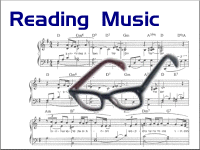|
5. Reading and notating music.
Grades K-4
a. read whole, half, dotted half, quarter, and eighth notes and rests in 2/4 , 3/4 , and 4/4 meter signatures
b. use a system (that is, syllables, numbers, or letters) to read simple pitch notation in the treble clef in major keys
c. identify symbols and traditional terms referring to dynamics, tempo, and articulation and interpret them correctly
when performing
d. use standard symbols to notate meter, rhythm, pitch, and dynamics in simple patterns presented by the teacher
Grades 5-8
a. read whole, half, quarter, eighth, sixteenth, and dotted notes and rests in 2/4 , 3/4 , 4/4 , 6/8 , 3/8 , and alla breve
meter signatures
b. read at sight simple melodies in both the treble and bass clefs
c. identify and define standard notation symbols for pitch, rhythm, dynamics, tempo, articulation, and expression
d. use standard notation to record their musical ideas and the musical ideas of others
Students who participate in a choral or instrumental ensemble or class:
e. sightread, accurately and expressively, music with a level of difficulty of 2, on a scale of 1 to 6
Grades 9-12
Proficient:
a. demonstrate the ability to read an instrumental or vocal score of up to four staves by describing how the elements
of music are used
Students who participate in a choral or instrumental ensemble or class:
b. sightread, accurately and expressively, music with a level of difficulty of 3, on a scale of 1 to 6
Advanced:
c. demonstrate the ability to read a full instrumental or vocal score by describing how the elements of music are used
and explaining all transpositions and clefs
d. interpret nonstandard notation symbols used by some 20th- century composers
Students who participate in a choral or instrumental ensemble or class
e. sightread, accurately and expressively, music with a level of difficulty of 4, on a scale of 1 to 6
|



